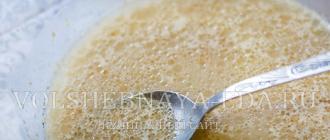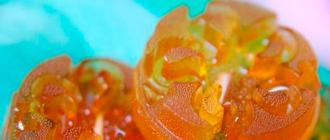TORSION
Sequence of solving the problem
1. Determine external torsional moments using the formula
M=P/ω
Where R - power,
ω - angular velocity.
2. Since with uniform rotation of the shaft the algebraic sum of the external twisting (rotating) moments applied to it is equal to zero, determine the balancing moment using the equilibrium equation
∑ M i z = 0
3. Using the section method, construct a diagram of torques along the length of the shaft.
4. For the section of the shaft in which the greatest torque occurs, determine the diameter of the shaft with a round or annular cross-section based on the conditions of strength and rigidity. For the annular section of the shaft, take the diameter ratio
Where d O- inner diameter of the ring;
d - outer diameter of the ring.
From the strength condition:
From the rigidity condition:


Where M zmax- maximum torque;
W p - polar torsional moment;
[τ cr] - permissible shear stress
Where J p - polar moment of inertia of the section;
G - shear modulus of elasticity;
[φ O] - permissible angle of twist of the section
Shaft cross section - circle


Required shaft diameter for strength:
Required shaft diameter for rigidity:


Shaft section - ring


Required strength outer ring diameter:
Required rigidity outer diameter of the ring:


Example 1 . For a steel shaft (Fig. 1) with a constant cross-section along the length, it is required: 1) determine the values of the moments M 2 And M 3 , corresponding to the transmitted powers R 2 And R 3 , as well as the balancing moment M 1 ; 2) construct a diagram of torques; 3) determine the required shaft diameter from calculations of strength and rigidity, assuming according to the option (A) (b) - c =d 0 / d=0.8.
Accept: [ τ cr ] = 30 MPa ; [ φ 0 ] = 0.02 rad/m; R 2 = 52 kW; R 3 = 50 kW; ω = 20 rad/s; G = 8 10 4 MPa

Rice. 1 - Problem diagram
Solution:
1. Determine external twisting moments:
M 2 = P 2 / ω = 52 10 3 / 20 = 2600 N m
M 3 = P 3 / ω = 50 10 3 / 20 = 2500 N m
2. Determine the balancing moment M 1 :
∑ M i z = 0; M 1 – M 2 – M 3 =0
M 1 = M 2 + M 3 = 5100 Nm
3. Determine the torque by sections of the shaft:
M z I= M 1 = 5100 N m
M z II= M 1 – M 2 = 5100 – 2600 = 2500 N m
We build a diagram of torques Mz(Fig. 2).

Rice. 2 - Torque diagram
4. We determine the diameter of the shaft from the conditions of strength and rigidity, takingM z max = 5100 N m(Fig. 2).
a) Shaft section – circle.
From the strength condition:
We accept d = 96 mm
From the rigidity condition:
We accept d = 76 mm
The required diameter turned out to be larger based on strength, so we accept it as the final d = 96 mm.
b) The cross section of the shaft is a ring.
From the strength condition:
We accept d = 114 mm
From the rigidity condition:
We accept d = 86 mm
The required diameters are finally taken from strength calculations:
Ring outer diameter d = 114 mm
Inner diameter of stake tsa d O = 0,8 d = 0,8 114 = 91.2 mm. We accept d O =92 mm .
Task 1. For a steel shaft (Fig. 3) constant cross section required: 1) determine the values of the moments M 1 , M 2 , M 3 And M 4 ; 2) construct a diagram of torques; 3) determine the diameter of the shaft from calculations of strength and rigidity, assuming according to the option (A) the cross section of the shaft is a circle; according to option (b)- cross-section of a shaft - a ring having a diameter ratio c =d 0 / d=0.7. Power at gear wheels accept R 2 = 0.5R 1 ; R 3 = 0.3Р 1 ; R 4 = 0.2Р 1 .
Accept: [ τ cr ] = 30 MPa ; [ φ 0 ] = 0.02 rad/m; G = 8 10 4 MPa
Round the final diameter to the nearest even (or ending in five) number.
Take the data for your option from Table 1
Note. Round the resulting calculated diameter value (in mm) to the nearest more, ending in 0, 2, 5, 8.
Table 1 - Initial data
Scheme number in Figure 3.2.5
P 1
Options
rad/s
kW

Rice. 3 - Problem diagram
When calculating strength in torsion (as well as in tension), three problems can be solved:
a) verification calculation - check whether the shaft can withstand the applied load;
b) design calculation - determine the dimensions of the shaft from the condition of its strength;
c) calculation based on load-bearing capacity - determine the maximum permissible torque.
1) using the diagram of the shaft and the torsional moments acting on it, a diagram of the internal torques is constructed in individual sections;
2) select the material for the calculated shaft and determine the permissible stress for this material, for example, according to formula (5.9), ;
3) for the shaft section with the maximum absolute value of the torque, write down the torsional strength condition
![]()
The design calculation is carried out based on the strength condition based on the following relationship:
For continuous round section, from here we can write an expression for determining the diameter of the shaft from the condition of its strength:
For annular section
![]()
Having determined the dimensions of the shaft from the strength condition, check the shaft for rigidity.
The rigidity condition requires that the maximum relative twist angle be less than or, in the extreme case, equal to the permissible twist angle per unit length of the shaft, i.e.
From the strength condition, one can find the polar moment of resistance of the section necessary to ensure strength, and from it the diameter of the shaft:
But Wp = 0,2d 3, That's why
![]()
From formula (5.11) you can find the required polar moment of inertia of the section, and from it the diameter of the shaft
In this formula, the permissible relative twist angle must be expressed in radians; if this angle is given in degrees, then the relationship for determining Ip will look like this:
But Ip = 0,1d 4, therefore
![]()
Of the two diameters calculated using formulas (5.12) and (5.13), the larger one is selected as the final diameter, which is usually rounded to whole millimeters.
In the case of calculating the dimensions of a shaft of an annular cross-section for a given ratio of the internal d internal and external diameters d, those. for a given parameter k = d vn /d, formulas (5.12) and (5.13) take the form:
![]()
![]()
Example 4.
Select the diameter of the solid shaft transmitting power N=450 hp at rotation speed n=300 rpm. The twist angle should not exceed one degree per 2 meters of shaft length; MPa, MPa.
Solution.
The torque is determined from the equation
The diameter of the shaft according to the strength condition is determined from the equation
![]()
The shaft diameter according to the rigidity condition is determined from the equation

Choose larger size 0.112 m.
Example 5.
There are two equal-strength shafts made of the same material, of the same length, transmitting the same torque; one of them is solid and the other is hollow with a cavity coefficient. How many times heavier is a solid shaft than a hollow shaft?
Solution.
Shafts of equal strength made of the same material are those shafts in which, at the same torques, the same maximum tangential stresses arise, that is
The condition of equal strength transforms into the condition of equal moments of resistance:
Where do we get it from:
![]()
![]()
The ratio of the weights of two shafts is equal to the ratio of their cross-sectional areas:

Substituting the ratio of diameters into this equation from the condition of equal strength, we obtain
![]()
As this result shows, a hollow shaft, being the same in strength, is twice as light as a solid one. This is explained by the fact that, due to the linear law of distribution of tangential stresses along the radius of the shaft, the internal layers are relatively lightly loaded.
Example 6.
Find the power in kW transmitted by the shaft if the diameter of the solid shaft d=0.15 m, the number of shaft revolutions per minute n=120, the shear modulus and the twist angle of the shaft section with a length of 7.5 m is equal to 1/15 radians.
Solution.
From the formula
Let's determine the transmitted power
Example 7.
Determine by what percentage the maximum stress on the shaft during torsion will increase if a central hole is made in the shaft (C = 0.4).
Solution.
Assuming , we obtain the following expressions for the stresses of solid and hollow shafts:
![]()
![]()
The desired voltage difference
Example 8.
Replace solid diameter shaft d=300 mm with a hollow shaft of equal strength with an outer diameter of =350 mm. Find the internal diameter of the hollow shaft and compare the weights of these shafts.
Solution.
The highest tangential stresses in both shafts must be equal to each other:
![]()
From here we determine the coefficient WITH
![]()
Hollow shaft inner diameter
The ratio of the weights is equal to the ratio of the cross-sectional areas:
From the given examples 5 and 6 it is clear that the production of hollow shafts, i.e. shafts in which the lightly loaded internal part is removed is very effective means reducing material costs and, consequently, lightening the weight of the shafts. In this case, the highest stresses arising in a hollow shaft differ little from the maximum stresses in a solid shaft with the same outer diameter.
So in example 5, due to drilling at , which lightens the shaft by 16%, maximum voltages in the outer fibers of the hollow shaft increased by only 2.6%. In example 6, an equal-strength hollow shaft, but with a slightly larger outer diameter compared to a solid shaft, turned out to be 53.4% lighter than a solid shaft. These examples clearly demonstrate the rationality of using hollow shafts, which is widely used in some areas of modern mechanical engineering, in particular in engine building.
Example 9.
On a section of a solid round shaft D=10 cm torque applied T=8 kNm. Check the strength and rigidity of the shaft if τ adm =50 MPa, TO t adm =0.5 deg/m and shear modulus G=0.8∙10 5 MPa.
Solution.
Condition of safe strength
Having expressed K t in the dimension deg/m, we get
which exceeds the permissible relative twist angle K t adm =0.5 deg/m by 16%.
Consequently, the strength of the shaft is ensured τ m ax = 40.75 MPa< 50 МПа, а жёсткость не обеспечена.
Example 10.
Ring-section steel shaft D=10 cm, d=8 cm is loaded with a moment that causes τ max =τ adm =70 MPa. What happens if this shaft is replaced with a solid round shaft with a diameter of 8 cm (the material is preserved).
Solution.
Maximum shear stress in the shaft
For an annular section and for a solid shaft ![]() . According to the condition for an annular shaft τ
max = 70 MPa, it is obvious that for a solid-section shaft the maximum stresses will be greater by as many times as its moment of resistance is less.
. According to the condition for an annular shaft τ
max = 70 MPa, it is obvious that for a solid-section shaft the maximum stresses will be greater by as many times as its moment of resistance is less.
Example 11.
For a solid shaft (example 10), determine whether plastic deformations have appeared if it is known that n adm = 1.8?
Solution.
For plastic materials n adm =τ max /τ adm, therefore τ у =70∙1.8=126 MPa.
The operating stresses exceeded the yield strength, resulting in plastic deformations.
Example 12.
Torsional moments are applied to the steel shaft (see Fig. 5.10): M 1, M 2, M 3, M 4. Required:
1) build a diagram of torques;
2) for a given value, determine the diameter of the shaft based on strength and round its value to the nearest larger value, respectively equal to: 30, 35, 40, 45, 50, 60, 70, 80, 90, 100 mm;
3) construct a diagram of twist angles;
4) find the largest relative angle of twist.
Given: M 1 = M 3 = 2 kNm, M 2 = M 4 = 1.6 kNm, a = b = c= 1.2 m, = 80 MPa.

Fig.5.10
Solution.
1. Construct a diagram of torques.
When constructing diagrams M kr we will accept the following rule of signs: the torque is considered positive if, when looking at the end of the cut-off part of the beam, the moment acting on it appears to be directed clockwise.
The torques arising in the cross sections of the beams are determined from the external torques using the section method. Based on the section method, the torque in an arbitrary cross section of a beam is numerically equal to the algebraic sum of the external twisting moments applied to the beam on one side of the section in question.
For beams that have one fixed (embedded) end and one free end, it is convenient to express the torques of all cross sections in terms of external moments applied on the side of the section in question on which the free end is located. This allows you to determine torques without calculating the reactive torque occurring in the seal.
To construct a diagram of torques, it is necessary to find the values of torques on each section of the shaft.
Section I ( KD):
Section II ( SD):
Section III ( NE):
Section IV ( VA):
Based on the meaning of these moments we build a diagram M kr at the selected scale. Positive values M we put the cr ones up, the negative ones - down from the zero line of the diagram (see Fig. 5.11). mm. Torque – 40 Nm. Shear modulus of pipe material
Select the dimensions of the cross section of the shaft (Fig. 1) according to the strength condition. In sections from section 1 to section 3 and from section 5 to section 6, the outer diameter of the shaft, for design reasons, must have the same size.
In the section from section 1 to section 2, the shaft has an annular cross-section with n=d B /d=0.4. In sections from section 3 to section 5, the shaft is selected only according to strength conditions.
M = 1 kN∙m, [τ ] = 80 MPa.
Solution
We divide the shaft into power sections and build a torque diagram (Fig. 1, b).
Determine the shaft diameters. In sections I, II and V, the outer diameter of the shaft is the same. For them, it is not possible to indicate in advance the section with the highest tangential stress value, since different sections have various types cross section: section I – circular, section II and V – solid round.
It is necessary to determine separately, according to the strength condition, the diameters for each type of cross section for the most loaded force section (that is, the one on which the maximum force is applied). absolute value torque). We will finally accept the largest diameter obtained.
For a section with a ring cross-section:
For a shaft of solid cross-section

We finally accept highest value the resulting diameter, rounded up to the nearest whole value:
d 1 = d 2 = d 5 = 61 mm;
d B1 = n∙d 1 = 0.4∙61 = 24.4 mm.
The highest voltage acting in these areas is:
Shaft diameter in section III (M K3 = 5M = 5 kNm).
Torsion of a rod of circular cross-section – problem condition
Four external torsional moments are applied to a steel shaft of constant cross-section (Fig. 3.8): kN m; kN m; kN m; kNm. Lengths of rod sections: m; m, m, m. Required: construct a diagram of torques, determine the diameter of the shaft at kN/cm2 and construct a diagram of the twist angles of the cross sections of the rod.
Torsion of a round rod - design diagram
 Rice. 3.8
Rice. 3.8
Solution to the problem of torsion of a round rod
Determine the reactive torque arising in a rigid seal
Let's designate the moment in the embedding and direct it, for example, counterclockwise (when looking towards the z-axis).
Let's write down the balance equation for the shaft. In this case, we will use the following sign rule: external twisting moments (active moments, as well as the reactive moment in the seal), rotating the shaft counterclockwise (when looking at it towards the z axis), are considered positive.
The plus sign in the expression we obtained indicates that we guessed the direction of the reactive torque arising in the seal.
We build a diagram of torques
Let us recall that the internal torque arising in a certain cross section of the rod is equal to the algebraic sum of the external twisting moments applied to any of the parts of the rod under consideration (that is, acting to the left or to the right of the section made). In this case, the external twisting moment, which rotates the part of the rod under consideration counterclockwise (when looking at the cross section), is included in this algebraic sum with a plus sign, and along the way - with a minus sign.
Accordingly, the positive internal torque counteracting the external twisting moments is directed clockwise (when looking at the cross section), and the negative one is counterclockwise.
We divide the length of the rod into four sections (Fig. 3.8, a). The boundaries of the sections are those sections in which external moments are applied.
We make one section at a random location in each of the four sections of the rod.
Section 1 – 1. Let’s mentally discard (or cover with a piece of paper) the left side of the rod. To balance the twisting moment kN m, an equal and oppositely directed torque must arise in the cross section of the rod. Taking into account the above mentioned sign rule
![]() kNm.
kNm.
Sections 2 – 2 and 3 – 3:
Section 4 – 4. To determine the torque, in section 4 – 4 we discard the right side of the rod. Then
![]() kNm.
kNm.
It is easy to verify that the result obtained will not change if we discard now not the right, but the left part of the rod. We get
To construct a diagram of torques, draw a thin line along the axis parallel to the rod axis z (Fig. 3.8, b). The calculated values of torques on the selected scale and taking into account their sign are plotted from this axis. Within each section of the rod, the torque is constant, so we seem to “shade” the corresponding section with vertical lines. Let us recall that each segment of the “hatching” (the ordinate of the diagram) gives, on the accepted scale, the value of the torque in the corresponding cross section of the rod. We outline the resulting diagram with a thick line.
Note that in the places where external twisting moments are applied on the diagram, we received an abrupt change in the internal torque by the value of the corresponding external torque.
Determine the shaft diameter from the strength condition
The torsional strength condition has the form
 ,
,
Where ![]() – polar moment of resistance (moment of resistance during torsion).
– polar moment of resistance (moment of resistance during torsion).
The greatest absolute value of torque occurs in the second section of the shaft: ![]() kN cm
kN cm
Then the required shaft diameter is determined by the formula
 cm.
cm.
Rounding the resulting value to the standard value, we take the shaft diameter to be equal to mm.
We determine the angles of twist of cross sections A, B, C, D and E and construct a diagram of the angles of twist
First, we calculate the torsional stiffness of the rod, where G is the shear modulus, and ![]() – polar moment of inertia. We get
– polar moment of inertia. We get
The angles of twist in individual sections of the rod are equal:
 glad;
glad;
 glad;
glad;
 glad;
glad;
 glad.
glad.
Angle of twist in the seal equal to zero, that is . Then
The diagram of twist angles is shown in Fig. 3.8, c. Note that within the length of each section of the shaft, the twist angle changes according to a linear law.
An example of a problem on torsion of a “round” rod for independent solution
Conditions for the problem of torsion of a “round” rod
A steel rod (shear modulus kN/cm2) of circular cross-section, rigidly clamped at one end, is twisted by four moments (Fig. 3.7).
Required:
· construct a diagram of torques;
· for a given permissible tangential stress kN/cm2, from the strength condition, determine the diameter of the shaft, rounding it to the nearest following values 30, 35, 40, 45, 50, 60, 70, 80, 90, 100, 200 mm;
· construct a diagram of the angles of twist of the cross sections of the rod.
Variants of calculation schemes for the problem of torsion of a round rod for independent solution

An example of a problem on torsion of a round rod - initial conditions for independent solution
| Scheme number | ||||||||
|
2. Torsion.
2.4. Construction of diagrams of angular displacements during torsion.
Having formulas for determining deformations and knowing the conditions for fastening the rod, it is not difficult to determine the angular displacements of the sections of the rod and construct diagrams of these displacements. If there is a shaft (i.e., a rotating rod) that does not have fixed sections, then to construct a diagram of angular displacements, some section is taken as conditionally fixed.
Let's consider concrete example(Fig. 2.12, a). In Fig. 2.12, b the diagram Tk is given.
Let us take the section at point A as conditionally stationary. Let us determine the rotation of section B relative to section A.
Where TAB is the torque in section AB; lAB is the length of section AB.
Let us accept the following sign rule for the angles of rotation of sections: the angles will be considered positive when the section rotates (when looking along the axis from right to left) counterclockwise. In this case it will be positive. On the accepted scale, we will plot the ordinate (Fig. 2.12, c). We connect the resulting point K with a straight point E, since in section AB the angles change according to the law of a straight line. Let us now calculate the angle of rotation of section C with respect to section B. Taking into account the accepted rule of signs for angles of twist, we obtain
Since section B is not stationary, the angle of rotation of section C with respect to section A is equal to
The twist angle can be positive, negative and, in a particular case, equal to zero.
Let's assume that in this case the angle is positive. Then, putting this value on the accepted scale upward from the diagram, we obtain point M. Connecting point M with point K, we obtain a graph of twist angles in the section BC. In section CD, no twisting occurs, since the torques in this section are equal to zero, so all sections there rotate by the same amount as section C rotates. Section MN of the diagram here is horizontal. The reader is invited to make sure that if we take B as a fixed section, then the diagram of the twist angles will have the form shown in Fig. 2.12, g.
Example 2.1. Determine the diameter of a steel shaft rotating at an angular speed of W = 100 rad/s and transmitting power N = 100 kW. Allowable stress = 40 MPa, permissible twist angle = 0.5 deg/m, G = 80000 MPa.
Solution. The moment transmitted by the shaft is determined by the formula
T = N/W = 100,000 / 100 = 1000 N * m
The torque in all cross sections of the shaft is the same
Tk = T = 1000 N * m = 1 kN * m = 0.001 MN * m.
The diameter of the shaft in terms of strength is determined by formula (2.15)
Using formula (2.24), we determine the shaft diameter from the rigidity condition
The shaft diameter in this case is determined from the rigidity condition and should be taken equal to d = 52 mm.
Example 2.2. Select the cross-sectional dimensions of a tubular shaft transmitting a moment T = 6 kN * m, with a diameter ratio c = d/D = 0.8 and permissible stress = 60 MPa. Compare the weight of this tubular shaft with a solid section shaft of equal strength.
Answer. Dimensions of the tubular shaft: D = 9.52 cm, d = 7.62 cm. Sectional area At = 25.9 square cm. Diameter of the solid shaft d1 = 8 cm. Sectional area Ac = 50.2 square cm. Mass of the tubular shaft makes up 51% of the mass of the solid shaft.






